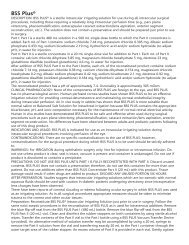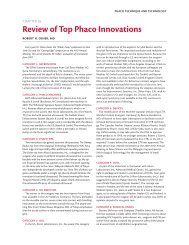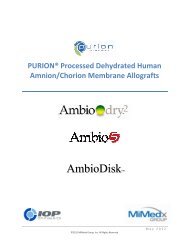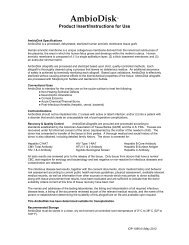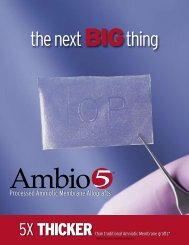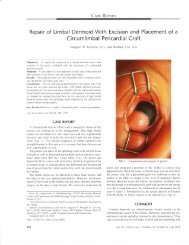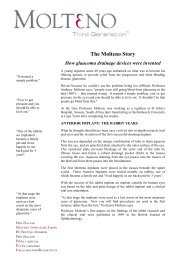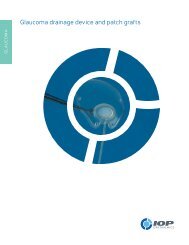You also want an ePaper? Increase the reach of your titles
YUMPU automatically turns print PDFs into web optimized ePapers that Google loves.
An Introduction toMOITENO@ IMPLANT S Ghu,oma <strong>Drainage</strong> DeuicesBuphthalmos and Juvenile <strong>Glaucoma</strong> treated by Molteno@ Implant.Molteno@ Implants are indicated as the primary operation in cases of juvenile glaucoma and in buphthalmos associated with Sturge-Weber Syndrome, neurofibromatosis, congenital cataract or uveitis. In these cases the Molteno@ Implant of choice is a Pressure RidgeSingle Plate Molteno@ Implant [DlJ in infants under l8 months of age while Pressure Ridge Double Plate Molteno@ Implants[DRZ/DL2] are generally used in patients over 18 months of age.CASE STUDY | - Buphthalmos due to Sturge-Weber SyndromeThis child was referred at the age of 7 months with a history ofpoor vision since birth. On examination, the corneas were l4 mm indiameter andhazy.A bilateral capillary haemangioma involved theskin of the upper face including the eyelids and the conjunctiva ofboth eyes. Under anaesthesia, the IOP was 32 mmHg [R) and 37mmHg [L]. A Pressure Ridge Single Plate Molteno@ Implant (D1]was inserted into each eye with the tube tied off with 5.0 Vicryl,An infant with bilateral bupthalmos dueto Sturge-Weber Syndrome, after insenionof a MoLtenot!') ImpLantcombined with a Sherwood slit. The left eye was operated first and the right eye a week later. At operation abnormal blood vesselscovering the anterior one third of the sclera were treated by thermocautery. The postoperative course was uneventful and when lastseen 5 years after operation the IOP in both eyes was 15 mmHg on no treatment.CASE STUDY 2 - Juuenile <strong>Glaucoma</strong> This young man had a lens extraction for congenital cataract in early childhood. At the age of34 he developed glaucoma. Preoperatively the IOP was 30 mmHg on acetazolamide and timolo1. At operation a Double PlateMolteno@ Implant (L2J was inserted, with Vicryl-tie for delayed drainage. There were no postoperative complications. The IOP hasranged between 72 and 16 mmHg on no treatment over the 15 years of followup.Tiaumatic <strong>Glaucoma</strong> treated by Molteno@ Implant.Tiaumatic glaucoma generally occurs in young people and is frequentiy associated with damage to the lens and other ocularstructures. While conventional surgery gives poor results, in these cases Moltenb@ Implants provide a robust drainage system withgood long term control of IOP. Double Plate Implants are generally recommended in these mostly young and healthy cases.CASE STUDY This young man was struck in the right eye by a stone when he was 11 years old.He developed traumatic glaucoma which was drained by trabeculectomy at the age of 24 years.The trabeculectomy failed after 5 years. Preoperatively his IOP was 45- 50 mmHg on pilocarpine andtimolol. At operation a Double Plate Molteno@ Implant [R2) was inserted with delayed drainage byb,vo-stage operation. (Before the introduction of absorbable sutures delayed drainage required twoseparate operations. Now a single operation with a Vicryl ligature around the translimbal tube wouldbe performed). The postoperative course was smooth and no hypotensive medication was required.When last seen 1 9 years later the IOP was controlled at between 13 and I 7 mmHg on no treatment.The Place of Molteno@ Implants in the management of Primary Open Angle <strong>Glaucoma</strong>.Tiabeculectomy is generally the treatment of first choice in cases of primary glaucoma requiringdrainage surgery. However, Molteno@ Implants are indicated where there are additional risk factorssuch as advanced field loss, compiications of or failure of trabeculectomy in the fellow eye, lensopacities or mental states limiting patient cooperation with other treatments.CASE STUDY The patient underwent trabeculectomy for open angle glaucoma in the left eye.The trabeculectomy failed with progression of field loss and loss of central vision. Preoperative IOPon timolol and acetazolamide was 28 mmHg and visual acuity was 6/24. A, Pressure Ridge DoublePlate Molteno Implant@ [DL2] with Vicryl-tie and Sherwood slit was inserted. The postoperativecourse was smooth and uneventful. Currently, eight years after operation, the IOP is l2 mmHg onA case of primary open angle glaucoma3 years at'ter the insertion of Pressure Ridge
Molteno@ Implants in Chronic Uveitis with Secondary <strong>Glaucoma</strong>.In cases of chronic uveitis with secondary glaucoma, conventional drainage operations, with or without cytostatic agents, commonly faildue to recurrent inflammation which results in scarring and obliteration of the drainage system. Long term studies have shown that theinsertion of a Molteno@ Implant in these cases controls the intraocular pressure in75o/o of cases over a followup period of up to 20years. The drainage system provided by the Molteno@ Implant is exceptionally robust and continues to function well despite continuousactivity of the uveitis, acute exacerbations of the uveitis and all subsequent surgery including cataract extraction, corneal grafting andvitrectomy. In cases where the uveitis is well controlled, the visual acuity and visuai fields are maintained and the proportion of casesrequiring steroids, and the doses required, falls progressively over the years. Failures, when they occur, are associated whichcomplications due to advanced disease, previous intraocular surgery and failure to control the uveitis.CASE STUDY A patient aged 48 years presented with glaucoma secondary to granulomatousuveitis [Bovine TB]. Preoperatively the IOP was 28-32 mmHg on medication which includedacetazolamide, beta-blockers, topical steroids and anti-tuberculous treatment. At operation aPressure Ridge Double Plate Molteno@ Implant [DR2] with Vicryl-tie for delayed drainage wasinserted. The postoperative course was smooth. When last seen two and a half years later the IOPwas 10 mmHg without the need for hypotensive medication.Re;| Molteno A, Sayarvat N, Herbison P. Long tem resuhs of uueitis with sccondary glaucoma drained lry Mobenoa lmplants. Opthamology (2001J I 08:605-613Combined Molteno@ Implant and Cataract Extraction.Where cataract and glaucoma occur together, a single operation combining cataract extraction and Molteno@ Implant with delayeddrainage provides a safe and very effective procedure for removing the cataract and controlling the IOP.The procedure involves three steps: [1] Placing the implant on the sclera, measuring and cutting the tube to the correct length andthen tying off the tube with a Vicryl ligature; (2] Performing a standard cataract extraction; [3J Inserting the tube into the anteriorchamber. Hypotensive medication is continued until the Vicryl dissolves 3-5 weeks later and aqueous drains into the preformed b1eb.CASE STUDY A man aged 89 years with primary glaucomaand age-related macular degeneration, developed a cataract in his 30.00left eye. The other eye had been lost to absolute glaucomasome years earlier. His compliance with medical treatment waspoor due, in part, to mild dementia [Alzheimers disease] . 20.00Preoperatively his IOP was 30 mmHg on acetazolamide andtimolol. At operation the cataract was removed by extracapsularlens extraction and an intraocular lens inserted. At the same 1000operation a Pressure Ridge Single Plate Molteno@ Implant [DlJwas inserted and delayed drainage achieved by utilising theVicryl-tie technique. The postoperative course was smooth and0 00no hypotensive medication was needed. Five years afteroperation his IOP is 10 mmHg on no medication.IOP over timeMonths after surgeryNeovascular <strong>Glaucoma</strong> treated by Molteno@ Implant.Molteno@ Implants are the treatment of first choice in cases of neovascular glaucoma. In these severeiy compromised eyes,immediate drainage of aqueous using a Pressure Ridge Molteno@ Implant is recommended, with either a Single Plate [DlJ or DoublePlate Molteno@ Implant (DR2/DL2) depending on the amount of drainage required. With management of the patient's generalphysical state, treatment of the precipitating disorder and an ongoing programme of retinal photocoagulation where indicated, goodcontrol of IOP can be achieved in 70o/o of eyes with maintenance or improvement in pre-operative vision in 600/o of these.CASE STUDY I A patient with adult onset diabetes with retinopathy [which had been managed by retinal photocoagulation]developed neovascular glaucoma shortly after cataract extraction at the age of 59 years. His right eye was drained by trabeculectomywhich failed and became phthisical. Subsequentiy, his left eye was drained by Molteno@ Implant. Preoperatively his cornea wascloudy and the IOP was 24-38 mmHg on timolol, epinephrine and acetazolamide. At operation a Pressure Ridge Single PlateMoiteno@ Implant [Dl) was inserted for immediate drainage to prevent further loss of vision. The operation cleared the corneasufficiently for additional retinal photocoagulation. Following the operation his IOP was controlled on timolol. Four years later theIOP rose and was treated by further retinal photocoagulation. At the time of his death 5 years after operation he had useful visionwith an acuity of 6/18 [20l60J and an IOP of l2-17 mmHg.CASE STUDY 2 A case of acute neovascular glaucoma in anaphakic eye, in a patient with severe diabetic retinopathy and renalinsufficiency. The diabetic retinopathy had been treated byphotocoagulation. Prior to surgery, the IOP was 58 mmHg and thevisual acuity was light perception. A Single Plate Molteno@ Implant(S1) was inserted as a emergency procedure to preserve theremaining vision. Postoperatively the IOP was controlled at15 mmHg on acetazolamide 120mg, 2x/day, and the vision was Same eye after insertion of a Mobeno@
Aphakic <strong>Glaucoma</strong> treated by Molteno@ Implant.The results of trabeculectomy are poor when primary glaucoma is complicated by aphakia and rncases where the normal anatomy of the eye is disturbed. In such cases insertion of a Molteno@Implant is recommended as it allows the position of the tube to be selected to ensure unobstructeddrainage of aqueous with long term control of IOP.CASE STUDY This 70 year old patient had history of a right intracapsular cataract extraction withvitreous loss followed, I I years later, by an anterior vitrectomy and placement of an anteriorchamber IOL. The eye subsequently developed glaucoma which could not be controlled byhypotensive medication. Preoperatively the IOP was 23-44 mmHg on acetazolamide, pilocarpineand timolol. A Pressure Ridge Double Plate Molteno@ Implant [DRZ] with Vicryl-tie for delayed drainage, was inserted with thetube placed into the posterior chamber via a pars plana incision. The postoperative course was smooth. When last seen five yearsafter the operation her IOP was 12 to 15 mmHg on timolol only.Imponant considerations for the surgeon:<strong>Drainage</strong> Area - Single or Double Plate Molteno@ Implant?The area needed for drainage and adequate long term control of IOP depends on the patient's age, general health and the severity ofthe glaucoma. In general, the greater the amount of aqueous to be drained and the stronger the patient's fibrosing response toType of Molteno@ Implant<strong>Glaucoma</strong> <strong>Drainage</strong> DevicePressure Ridge Single Plate (Dl)Pressure Ridge Double Plate (DLZIDR2)Single Plate (Sl)Double Plate (L2lR2)Mt.r"phth;i"rt. (Ml)Immediate <strong>Drainage</strong> I Delayed <strong>Drainage</strong>Ciliarv Bodv FunctionPoor Good i Poor Goodglaucomatous aqueous the greater the areaneeded for drainage. As a general rule, andsubject to the surgeon's experience andclinical judgement, single plate implants areused in infants under 18 months, those infrail general health or very elderly and wherethe eye has had a cyclodestructive operationor multiple intraocular procedures. Doubleplate implants are used in most younger andfitter patients and in elderly patients in goodgeneral health.Surgical technique - Immediate or delayed drainage?Molteno@ Implants may be inserted for immediate or delayed drainage. Delayed drainage is recommended wherever possible as itgreatly reduces the incidence of postoperative hypotony and gives a thinner bleb lining with superior long term control of IOP.Delayed drainage.<strong>Drainage</strong> of aqueous may be delayed by tying an absorbable suture such as 5.0 Vicryi, the 'Vcryl-tie', around the translimbal tube ofthe implant close to the plate. This allows time for the formation of a thin bleb lining, the 'preformed bleb', in the tissues around theplate. When the Vicryl-tie dissolves 4 to 5 weeks after operation the tube opens and aqueous drains into the 'preformed bleb'effectively preventing post-drainage hypotony. During this time the IOP is controlled by hypotensive medication supplemented, ifnecessary, by making a relieving slit in the side of the translimbal tube the 'sherwood slit' . This slit acts as a safety valve and releasesaqueous if the IOP rises above normal levels. It ceases to function about 4 weeks after operation around the time the Vicryl-tiedissolves.Immediate drainage.Immediate drainage may be preferable where the eye is acutely inflamed and when immediate reduction of IOP is required .Examples include acute neovascular glaucoma or glaucoma associated with uveitis. Use of a Pressure Ridge Molteno@ Implant insuch cases reduces the risk of postoperative hypotony.Immediate plus delayed drainage - a compromise.In cases where a double piate implant is used and where immediate drainage is demanded, a compromise can be achieved by placinga Vicryl-tie on the tube between the two plates rather than on the translimbal tube. This gives immediate drainage of aqueous intothe tissues around the first plate with delayed drainage to the 'preformed bleb' around the second plate. The implant of choice forthis procedure is a Pressure Ridge Double Plate Molteno@ Implant (DLZIDRZJ.Hypotensive medication after Molteno@ Implant surgery. "Keep the Pressure Down"When the IOP is kept within normal limits there is a thinning of the bleb lining with a gradual and progressive fall in IOP. If theIOP is well controlled after Molteno@ Implant surgery [by hypotensive agents if necessary), there is a long term tendency for the IOPto fall and the need for hypotensive medication to decrease. On average, about 500/o of cases need some hypotensive medication inthe first year after Molteno@ Implant surgery. This proportion falls progressively to less than 20% after 5 years. Carbonic anhydraseinhibitors, beta-blockers and adrenergic agents are highly effective hypotensive agents after Molteno@ Implant surgery.CAUTION: Miotics, prostaglandin analogues and other local vasodilating agents may cause eleuation of IOP after implant surgeryand should be avoided.MOLTENO"OPHTHALMIC LIMITEDP O EOX {1322 . DI,INEDIN . NEW ZEALANDT[]. ++ 61 (0)3 479 2714. FAX ++ 64 [0]3 479 2444llvlAII- molteoo@c1ear.r.t nz . WEBSITE l'rvrv.molteno r omDetailed surgical guides and videosavailable from your distributor.



